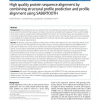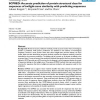294 search results - page 3 / 59 » Predicting the beta-helix fold from protein sequence data |
NAR
1998
13 years 5 months ago
1998
The FSSP database and its new supplement, the Dali Domain Dictionary, present a continuously updated classification of all known 3D protein structures. The classification is deriv...
BMCBI
2010
13 years 5 months ago
2010
Background: Protein alignments are an essential tool for many bioinformatics analyses. While sequence alignments are accurate for proteins of high sequence similarity, they become...
DMKD
2003
ACM
13 years 11 months ago
2003
ACM
Given a known protein sequence, predicting its secondary structure can help understand its three-dimensional (tertiary) structure, i.e., the folding. In this paper, we present an ...
BMCBI
2008
13 years 5 months ago
2008
Background: Protein structure prediction methods provide accurate results when a homologous protein is predicted, while poorer predictions are obtained in the absence of homologou...
BMCBI
2007
13 years 5 months ago
2007
Background: Protein remote homology detection is a central problem in computational biology. Most recent methods train support vector machines to discriminate between related and ...


